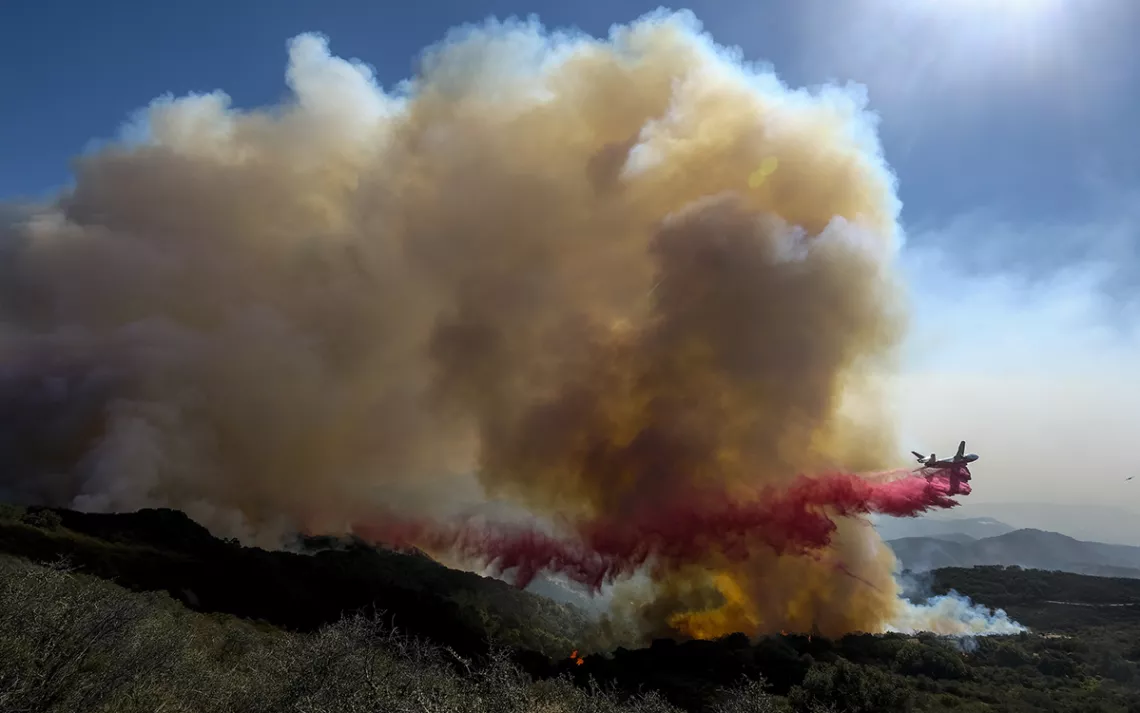2021: The Year in Climate Change
It was a record-breaking year. Not in a good way.

In the first weeks of 2021, extratropical cyclone Storm Filomena formed over the Atlantic Ocean and brought record-breaking blizzards and cold to the Iberian Peninsula. Over 20 inches of snow fell, temperatures dipped to negative 11 degrees Fahrenheit, $1.6 billion in damages were recorded, and Madrid recorded its heaviest snowfall in 40 years.
Just a month later, a historic deep freeze gripped the Texas plains. Much of the state dipped to 10 and 20 degrees below zero, and the icing-over of electrical infrastructure led to 5 million Texans losing power during the storm’s peak, many for days on end. Frozen pipes left more than 12 million in the state without access to water.
The month after that, sandstorms ravaged Beijing’s air, turning the sky yellow and the sun blue. A record-setting June heat wave swamped Portland in 116-degree heat and killed over 500 people in western Canada. Belgium, Luxembourg, and Germany experienced extreme rainfall in July, flooding the Rhine River and many residential towns. California’s Dixie Fire grew to the largest recorded wildfire in the state’s history. Dramatic drought, heat waves, and wildfires spread north to south through the African continent, from Algeria to Angola.
It all sounds like an apocalyptic “Spotify Wrapped.” But these extreme events are also a part of a larger story about changing weather worldwide. Here are four discoveries this year that show how those patterns are shifting.
The American West keeps getting smokier
Heat waves and wildfires struck around the world this year—hundreds of people died in western Canada’s June heat wave, and wildfires broke out in Greece, then Italy, then Turkey. California and Siberia never stopped burning all summer.
Large fires have always burned in the American West and the Pacific Northwest, says Susan Prichard. In fact, the amount of area burning right now is comparable to events in the past. What distinguishes many of today’s most devastating wildfires from their ancestors is severity.
“Modern forests, where fires become an infrequent visitor, are much denser and have multiple layers to them,” Prichard says. “There’s a lot more fuel to burn, and most trees die in these fires.”
More fuel has meant more smoke. “It’s like living in Mordor,” Prichard says. In 2017, 2018, 2020, and again in 2021, smoke and smog from western wildfires drifted across the entire continental United States, as far east as New York City.
This ongoing phenomenon means that wildfire and public health will be “forever linked,” says James Crooks, who studies extreme weather and human health at National Jewish Health, a Denver-based academic hospital and leading respiratory clinic. In 2019, he contributed to a nine-year study that found pregnant mothers in Colorado with prolonged exposure to wildfire smoke had an increased risk of preterm birth and health risks for both the mother and baby. In 2020, reports from Australia revealed that mothers exposed to prolonged bushfire smoke were left with gray placentas, resembling those of heavy smokers.
“From an air-pollution point of view, rainfall events can clear pollutants from the air,” says Jason West, a scientist at the University of North Carolina who researches the intersectionality of air pollution and climate change. As warmer temperatures make precipitation less frequent and more severe, “the stagnation between rainfall events is when air pollution builds up.” Climate models from West’s lab predict that globally by 2100, an additional 250,000 deaths per year from air pollution will be a direct result of climate change alone.
Earth is literally getting dimmer
A paper published this August in Geophysical Research Letters looked at data collected at Big Bear Solar Observatory between 1998 and 2017 measuring earthshine (the sunlight bouncing off the earth and reflecting onto the moon). The research team found that Earth is absorbing more sunlight into the oceans, because of its thinning atmosphere, and reflecting less. As seen from outer space, our world is literally getting dimmer.
Rain fell on Greenland’s highest point—and is becoming more extreme everywhere
In August, instead of snow, rain fell for the first time at Greenland’s tallest point, a summit that had experienced above-freezing temperatures only three times before. About 337,000 square miles of the ice sheet experienced surface melting, flooding 7 billion tons of liquid water across the plane. The event was a reminder of the precariousness of ice around the world.
“Warming is happening everywhere,” says John Marsham, a professor at the University of Leeds who specializes in atmospheric convection and meteorology. With HyCRISTAL, a project focused on weather patterns in the African horn, Marsham and his Future Climate Africa research team are studying projections of erratic rainfall and warming temperatures.
Glaciers are found in only three locations on the African continent: atop Uganda’s Rwenzori Mountains, Kenya’s Mt. Kenya, and Tanzania’s Mt. Kilimanjaro. They are all forecast to disappear within the next few decades, according to the 2020 State of Climate in Africa report. This year, all three countries were battered by torrential “long rains” and droughts alike, each displacing thousands of people.
Precipitation extremes—torrential rains in certain areas, dry spells in others—are “robust signals of climate change,” Marsham says. In eastern Uganda, flash floods in September contrast harshly with projected droughts in the northern and western regions in 2022.
The phenomena follow “simple physics,” says Marsham: Warming temperatures make rain events less frequent, yet more severe. In New York City, subways became swimmable amid record rainstorms, and flood levels in Luxembourg, Belgium, and Germany rivaled those experienced during Indonesia’s typhoon season. These same climate-changing conditions make hurricanes more frequent and severe. Hurricane Harvey's and Ida's strong, dangerous winds, Jason West says, were examples of the influence of sea level rise and warm ocean temperatures.

Make every day an Earth Day
Get articles like this one sent directly to your inbox.
With this action you affirm you want to receive Sierra Club communications and may vote on policy designated by the Sierra Club Board.
Extreme weather also impacted Venezuela, a country that shares similar longitudes with the three African nations and also hugs the equator. Flash floods along the country’s Andes-adjacent western border decimated valley towns in Merida state earlier this autumn. Less than 20 miles away from the flooding, the Pico Humboldt glacier, Venezuela’s very last patch of ice, is sweating atop the country’s highest peak. Spanning four square miles in 1910, the glacier has since lost 99 percent of its mass (now about 330 square feet) and is expected to completely vanish within the next few years.
The United Nations announces the first climate-change-caused famine
In early November, Arduinio Mangoni, the country’s UN World Food Programme’s deputy director, described the situation in southern Madagascar as “basically the only, maybe the first, climate change famine on Earth.” The human toll of the country’s worst drought in 40 years has never been this large: As of early November, the UN classified 1.3 million Malagasi as IPC 3, 4, or 5—the three most acute tiers of food insecurity.
It’s a dubious distinction. Drought has played a role in other famines around the world, but other factors have typically compounded and driven hunger—the ongoing famines in Yemen, Ethiopia, and South Sudan largely driven by civil wars, government corruption, and resulting ecological mismanagement, for example.
The disaster is not sudden. Madagascar is entering its fifth official year of drought, during which the increasingly arid, desert-like southern regions—which rely almost entirely on subsistence agriculture for their food and economy—have celebrated only one good harvest. The drought has also caused “tiomenas” (red winds), wherein dust and sand, made looser by drought and soil erosion, are blown great distances and smother crops, water, and infrastructure.
“Rainfall in the south has been decreasing for at least the past 15 years, so what we see today is not just a consequence of this year only,” says Rondrotiana Barimalala, a climate scientist at the University of Cape Town and contributing author of this summer’s Intergovernmental Panel on Climate Change Sixth Assessment Report. “We cannot rule out the impact of climate change.”
In August, the IPCC released its newest assessment of global climate data in a report that UN Secretary-General António Guterres described as a “Code Red for humanity.” The record-breaking weather the world has experienced will continue, and if emissions continue as usual, global temperatures will continue rising a projected 2.7 degrees Celsius by century’s end.
In early November, people took to the streets in Glasgow and around the world, demanding governmental action throughout the two-week COP26 international climate summit. COP’s participants set goals and made pledges—including phasing out coal power, funding green energy projects, and pledging emissions reductions.
None of these pledges are enough to meet the emissions goals set out by the IPCC report, which calls on world leaders to end the reliance on fossil fuels and cut greenhouse gas emissions by 45 percent from their 2010 levels, by 2030. Continued consumption, and inaction, the report reiterates, will be felt the world over. This has certainly been true in 2021.
Change requires a passion for climate solutions. If true steps are taken for a better future, the bad weather of tomorrow might not always be the result of our collective inaction.
 The Magazine of The Sierra Club
The Magazine of The Sierra Club



